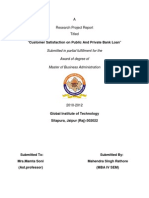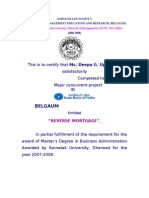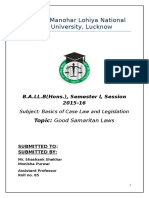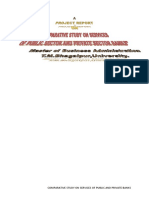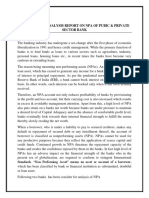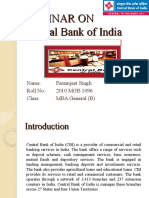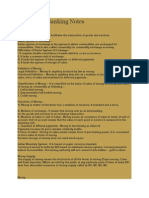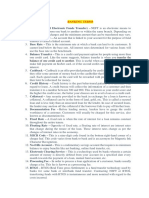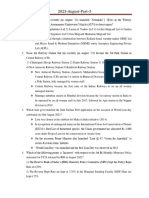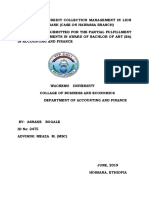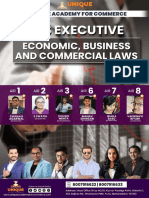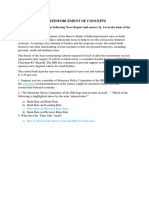0 ratings0% found this document useful (0 votes)
96 viewsCentral Bank
Central Bank
Uploaded by
Vrinda TayadeCentral Bank of India is one of India's largest public sector banks established in 1911. It was the first bank fully owned and managed by Indians. The bank has a presence across India and provides various banking products and services. Central Bank of India has grown significantly over its 104 year history and aims to leverage technology to improve customer experience and meet evolving customer needs through its diverse product offerings.
Copyright:
© All Rights Reserved
Available Formats
Download as DOCX, PDF, TXT or read online from Scribd
Central Bank
Central Bank
Uploaded by
Vrinda Tayade0 ratings0% found this document useful (0 votes)
96 views10 pagesCentral Bank of India is one of India's largest public sector banks established in 1911. It was the first bank fully owned and managed by Indians. The bank has a presence across India and provides various banking products and services. Central Bank of India has grown significantly over its 104 year history and aims to leverage technology to improve customer experience and meet evolving customer needs through its diverse product offerings.
Original Description:
project on central bank
Original Title
central bank
Copyright
© © All Rights Reserved
Available Formats
DOCX, PDF, TXT or read online from Scribd
Share this document
Did you find this document useful?
Is this content inappropriate?
Central Bank of India is one of India's largest public sector banks established in 1911. It was the first bank fully owned and managed by Indians. The bank has a presence across India and provides various banking products and services. Central Bank of India has grown significantly over its 104 year history and aims to leverage technology to improve customer experience and meet evolving customer needs through its diverse product offerings.
Copyright:
© All Rights Reserved
Available Formats
Download as DOCX, PDF, TXT or read online from Scribd
Download as docx, pdf, or txt
0 ratings0% found this document useful (0 votes)
96 views10 pagesCentral Bank
Central Bank
Uploaded by
Vrinda TayadeCentral Bank of India is one of India's largest public sector banks established in 1911. It was the first bank fully owned and managed by Indians. The bank has a presence across India and provides various banking products and services. Central Bank of India has grown significantly over its 104 year history and aims to leverage technology to improve customer experience and meet evolving customer needs through its diverse product offerings.
Copyright:
© All Rights Reserved
Available Formats
Download as DOCX, PDF, TXT or read online from Scribd
Download as docx, pdf, or txt
You are on page 1of 10
1
1. PROJECT OBJECTIVE To get the knowledge of basic aspect of an enterprise. To analyses
an enterprise with respect to set of basic parameters learns in this subject. To analyses
Central Bank of India in details.
2. 3. THE BANK WAS BROUGHT INTO EXISTENCE BY AN ORDINANCE ON 19TH JULY,
FOR TAKING OVER THE UNDERTAKING OF THE CENTRAL BANK OF INDIA, LTD. IN
TERMS OF THE ORDINANCE, THE UNDERTAKING OF "THE CENTRAL BANK OF INDIA,
LTD." WAS TRANSFERRED TO AND VESTED IN THE NEW BANK. THE ORDINANCE
WAS REPLACED BY THE BANKING COMPANIES ACT, 1969. THE ACT WAS DECLARED
NULL AND VOID BY THE SUPREME COURT ON 10TH FEBRUARY, 1970. AN
ORDINANCE WAS THEREUPON PROMULGATED WHICH WAS LATER REPLACED BY
THE BANKING COMPANIES ACT, 1970 WHICH WAS MADE EFFECTIVE
RETROSPECTIVELY FROM 19TH JULY, 1969. 1970 - 83 OFFICES WERE OPENED IN
THE LEAD DISTRICTS BRINGING THE TOTAL NUMBER OF OFFICES IN SUCH
DISTRICTS TO 139 AS AT 31ST DECEMBER. A TOTAL OF 817 BRANCHES WERE
OPENED BY THE BANK IN 47 DISTRICTS SINCE NATIONALISATION. 1982 - RS
2,50,00,000 WAS SUBSCRIBED BY GOVERNMENT. INTRODUCTION
3. 4. 1984 - One more regional rural bank was opened. Another 3 RRBs were set up in 1985,
raising the number of RRBs sponsored by the Bank to 23 covering 37 districts. 1985 - Rs
41.74 crores subscribed for by Government. 1995 - Rs 1256.46 crores subscribed for by
Government. 1996 - Rs 500 crores subscribed for by Government. 1997 - The Bank acted as
lead managers/co-managers in a few public/Rights issue besides taking up underwriting
commitments in a couple of issues. The bank also acted as bankers to 20 Mega Bond Issue
of lead financial institutions.
4. 5. HISTORY AND BACKGROUND Established in 1911, Central Bank of India was the first
Indian commercial bank which was wholly owned and managed by Indians. The
establishment of the Bank was the ultimate realisation of the dream of Sir Sorabji
Pochkhanawala, founder of the Bank. Sir Pherozesha Mehta was the first Chairman of a truly
'Swadeshi Bank'. In fact, such was the extent of pride felt by Sir Sorabji Pochkhanawala that
he proclaimed Central Bank of India as the 'property of the nation and the country's asset'.
He also added that 'Central Bank of India lives on peoplee's faith and regards itself as the
people's own bank'. During the past 104 years of history the Bank has weathered many
storms and faced many challenges. The Bank could successfully transform every threat into
business opportunity and excelled over its peers in the Banking industry.
5. 6. VISION STATEMENT To emerge as a strong, vibrant and pro-active Bank/Financial Super
Market and to positively contribute to the emerging needs of the economy through consistent
harmonization of human, financial and technological resources and effective risk control
systems. MISSION STATEMENT To transform the customer banking experience into a
fruitful and enjoyable one. To leverage technology for efficient and effective delivery of all
banking services. To have bouquet of product and services tailor-made to meet customers
aspirations. The pan-India spread of branches across all the state of the country will be
utilized to further the socio economic objective of the Government of India with emphasis on
Financial Inclusion.
6. 7. BORD OF DIRECTOR Shri. Rajeev Rishi Chairman & Managing Director Shri Raj Kumar
Goyal Executive Director Shri B.K. Divakara Executive Director Shri R.C. Lodha Executive
Director Dr. Saurabh Garg, GOI Nominee Director Shri Shekhar Bhatnagar RBI Nominee
Director Smt. N.S. Rathnaprabha Director Shri N. Nityananda Part Time Non Official Director
7. 8. CORPORATE SOCIAL RESPONSIBILITY CSR Initiative by Central Bank of India: As a
part of the CSR project undertaken by Central Bank of India, Mumbai, for the Tribal Welfare
Project, on 28th April 2016 they sponsored Cupboards for the school’s official use as well as
Cupboard for the school library along with Books to the Dahigaon-Jamghar Madhyamik
Vidyalaya in Dahigaon, Murbad 45 km far from Kalyan city. Central Bank of India has well
developed Corporate Social Responsibility inititatives in place. The focus on the Rural sector
is through Village Knowledge Centres and Farmers' Clubs etc. We also have schemes for
the girl child, where we take care of education expenses. Initiatives are in place in other
areas such as providing drinking water for schools, setting up bus shelters etc. All our CSR
initiatives have shown good results and they are an ongoing part of our contribution to the
building of this nation.
8. 9. ORGANIZATION STRUCTURE Board of Directors Chief Executive Personnel
development Research department Finance manager Law department Foreman machine
shop Foreman assembly shop Foreman receiving and shipping operators operators
operators Plant manager
9. 10. PRODUCTS OTHER PRODUCT : MASTER CARD PREPAID GIFT CARD VISA
PLATINUM CARD BANK VISA GOLD CARD CASH MANAGEMENT SERVICES CENT
BILLPAY BANCASSURANCE MUTUAL FUNDS DEPOSITORY SERVICES CENTRAL
CARD ELECTRONIC CENTRAL CARD DEBIT CARD Deposit Loan E-Payment
10. 11. HEADQUARTER IN INDIA Central Bank of India Chander Mukhi, Nariman Point Mumbai
– 400 021 Tel.: 022 – 6638 7777 CALL CENTER TOLL FREE NO ( 24 hours ) .-1800 200
1911
11. 12. COMPANY LOGO PUNCH LINE “BUILD A BETTER LIFE AROUND US“
12. 13. MARKET SHARE 25% 30%10% 35% Region Wise Market Share South North East West
SBI 28% ICICI Bank 22% HDFC Bank 19% CBI 24% OTHER BANK 7% Market share SBI
ICICI Bank HDFC Bank CBI OTHER BANK
13. 14. COMPANY LISTED CODE SHARE PRICE FACE VALUE : 10.00 CURRENT VALUE :
83.00 SHARE VALUE LOW – 82.40 HIGH – 88.60 PROFIT AND VOLUME RATIO (%) :
17.74 PE RATIO – 40.21 NSE code : CENTRALBK BSE code : 532885
14. 15. PROFITABLITY Sr no Year Profit(cr) 1 2010-11 7,532.70 2 2011-12 8,424.89 3 2012-13
9,092.63 4 2013-14 10,008.08 5 2014-15 9,364.25 0.00 5,000.00 10,000.00 15,000.00 2010-
11 2011-12 2012-13 2013-14 2014-15 Profit(cr) Profit(cr)
15. 16. GOVERNANCE PHILOSOPHY CORPORATE GOVERNANCE IS AN AGE OLD
CONCEPT WHICH PROVIDES FOR A SET OF TRANSPARENT RELATIONSHIPS
BETWEEN AN INSTITUTIONS MANAGEMENT, ITS BOARD, SHAREHOLDERS AND
OTHER STAKEHOLDERS. CORPORATE GOVERNANCE IS GAINING CENTRE STAGE
IN THE RECENT TIMES DUE TO FAILURE OF CORPORATE AND WIDE
DISSATISFACTION AMONG THE PEOPLE WITH THE WAY CORPORATE WORKS AND
HENCE BECAME A WIDELY DISCUSSED TOPIC WORLDWIDE. CORPORATE
GOVERNANCE IS NOW RECOGNISED AS A PARADIGM FOR IMPROVING
COMPETITIVENESS AND ENHANCING EFFICIENCY AND THUS IMPROVING
INVESTORS’ CONFIDENCE AND ACCESSING CAPITAL. NOW CORPORATE
GOVERNANCE HAS BECOME A MORE DYNAMIC CONCEPT AND A NOT A MERE
STATIC ONE.
16. 17. AWARDS BANK HAS BEEN AWARDED WITH TWO PRESTIGIOUS SKOCH GOLD
AWARDS DURING 2012-13 I. INNOVATIVE URBAN FINANCIAL INCLUSION II.
REACHING LAST MILE “CERTIFICATE OF EXCELLENCE” IN ESTABLISHING OF “RSETI”
(RURAL SELF EMPLOYMENT TRAINING INSTITUTE” ACROSS THE COUNTRY DURING
2011- 12 “OUTSTANDING LEADERSHIP AWARD” AT THE INSTITUTE OF PUBLIC
ENTERPRISE BANKING FINANCIAL SERVICES & INSURANCE, HYDERABAD
17. 18. FINDINGS AFTER STUDIED WHOLE INFORMATION OF CENTRAL BANK OF INDIA
WE FOUND THAT… THIS BANK IS THE LARGEST BANKING SERVICES COMPANY
INTO THE INDIA. THIS BANK IS ESTABLISHED IN 21 DECEMBER 1911;104 YEAR AGO
THIS BANK THE BUSINESS AREA OF THIS BANK IS ALL OVER THE WORLD THIS
COMPANY IS LISTED ON BSE AS WELL AS NSE MARKETS. THE REVENUE OF THIS
COMPANY IS INCREASES YEAR BY YEAR CENTRAL BANK OF INDIA HAS A STRONG
AND WELL-ARTICULATED SET OF PRODUCT OFFERINGS SUPPORTED BY
FINANCIAL MARKET.
18. 19. CONCLUSIONAFTER COLLECTING INFORMATION OF CENTRAL BANK OF INDIA
AND STUDIED THIS INFORMATION WE ARE CONCLUDE THAT THIS IS THE LARGEST
BANKING SERVICE COMPANY INTO THE WORLD AS WELL AS INDIA AND THIS
COMPANY IS CREATE GOOD RELATION WITH HIS CUSTOMERS. CENTRAL BANK OF
INDIA HAS BEEN KNOWN FOR THE PROCESS BEING ORIENTED WITH FOCUS ON
QUALITY AND COST SAVING. CENTRAL BANK OF INDIA LONG TERM STRATEGY TO
CREATE BRAND IMAGE AND NEW INNOVATION. WHEN THIS COMPANY WORKING
INTO THE MARKET THEN HE COLLECT FEEDBACK ABOUT HIS SERVICES TO
CUSTOMERS AND AFTER COLLECTING FEEDBACK COMPANY CREATE CHANGES
INTO THE SERVICES AND HE WILL GET MORE SATISFACTION FROM CUSTOMER
SIDE. THIS IS THE VERY LARGEST BANK INTO THE INDIA. THERE ARE LOT OF
COMPETITORS CREATE COMPETITION WITH THIS COMPANY AND THEY CREATE
NEW STRATEGY TO FACE THIS COMPETITION VERY SUCCESSFULLY. IN LAST WE
CONCLUDE THAT THIS COMPANY IS THE BIGGEST COMPANY INTO
ENTERTAINMENT AS WELL AS BANKING SECTOR IN INDIA. THIS COMPANY MAKES
VERY GOOD STRATEGY TO CREATE GOOD CONTROL INTO THE MARKET.
. role of central bank (1)
1. 1. Role of Central Bank
1. 2. Central Bank-- It is the Central Bank of India Established in “1st April1935” under the
“RESERVEBANK OF INDIA ACT”.Its head quarter is in Mumbai (Maharashtra). Its present
governor is “MR. D Subbarao”.It has “22 Regional Offices”, most of them in State capitals.
2. 3. BRIEF HISTORY It was set up on the recommendations of the “Hilton Young
Commission”.It was started as Share-Holders Bank with a paid up capital of 5 crores.
Initially it was located in Kolkata.It moved to Mumbai in 1937.Initially it was Privately
Owned.
3. 4. Since Nationalization in 1949, the Reserve Bank is fully owned by the Government of
India.
4. 5. PREAMBLE The Preamble of the Reserve Bank of India describes the basic functions of
the Reserve Bank as:- “…To regulate the issue of Bank Notes and keeping of reserves with
a view to securing monetary stability in India and generally to operate the currency and credit
system of the country to its advantage."
2. In every country, there is one bank which acts as the leader of the money market -
supervising, controlling and regulating the activities of Commercial Banks and other financial
institutions. It acts as a banker of issue and is in close touch with the government, as banker,
agent and adviser to the latter. Such a bank is known as the Central Bank of the country.
3. 3. Central Bank and Commercial Bank - Differences Central Bank does not work for profits
though it might secure profits. While Commercial Banks aim at securing maximum profit for
their shareholders, the Central Bank aims at controlling the banking system and supporting
the economic policy of the government. Central Bank is generally an organ of the
government and forms part of the govt. machinery. Commercial Banks may be owned by the
govt. or are privately owned. The Organization and Management of the Central Bank is fully
controlled by the Government.
4. 4. Functions of a Central Banka. Bank of Issue Central Bank has the exclusive monopoly of
note issue and the currency notes issued by the Central Bank are declared unlimited legal
tender throughout the country. This monopoly brings about:i. Uniformity of note issue which
in turn facilitates trade and exchange within the countryii. Enables the Central Bank to
influence and control the credit creation of Commercial Banksiii. Gives distinctive prestige to
the currency notesiv. Enables govt. to appropriate partly or fully the profits of note issue.
5. 5. Functions of a Central Bankb. Banker, Agent and Adviser to the Government As Banker
and Agent, RBI keeps the banking accounts of the Central and State governments and
makes and receives payments on behalf of the government. It provides short-term advances
to the govt. (ways and means advances) to tide over temporary shortage of funds. It advises
the govt. on all monetary and banking matters.c. Custodian of the Cash Reserves of
Commercial Banks All Commercial Banks keep part of their deposits as reserves with the
Central Banks and hence the name Reserve Bank of India. Centralised cash reserves serve
as the basis of a larger and more elastic credit structure and helps Commercial Banks to
meet crises and emergencies. Centralised cash reserves aids the Central Bank to control
credit creation and implement monetary policy.
6. 6. Functions of a Central Bankd. Custodian of Foreign Balances of the Country RBI holds the
foreign exchange assets of all commercial and non-Commercial Banks of the country. It is
the responsibility of RBI to maintain the rate of exchange and manage exchange control and
other restrictions imposed by the State. It also maintains reserves with the IMF and obtains
normal drawing and special drawing rights.e. Lender of the last resort Central Bank never
refuses to accommodate any eligible Commercial Bank experiencing cash shortage. In the
absence of a Central Bank, Commercial Banks will have to carry substantial cash reserves
which imply restricted lending and reduced income. As a lender of last resort, Central Bank
assumes the responsibility of meeting directly or indirectly all reasonable demands for
accommodation by the Commercial Banks.
7. 7. Functions of a Central Bankf. Central Clearance, Settlement and Transfer As the Central
Bank keeps cash reserves of Commercial Banks, it is easier for member banks to settle their
mutual claims in the books of the Central Bank. These are the clearing house operations of
RBI wherein cheques are cleared, claims settled and funds transferred in the books of the
member banks. However, this function can also be performed by any leading bank in a
locality or area.g. Controller of Credit RBI controls the level of credit in the economy by either
expanding or contracting bank deposits. In modern times, bank deposits have become the
most important source of money in the country. As controller of credit, RBI seeks to influence
and control the volume of bank credit and also to stabilize business conditions in the country.
8. 8. Functions of RBI Monetary Authority Formulates, implements and monitors the monetary
policy. Objective: maintaining price stability and ensuring adequate flow of credit to
productive sectors. Regulator and supervisor of the financial system Prescribes broad
parameters of banking operations within which the country’s banking and financial system
functions. Objective: maintain public confidence in the system, protect depositors’ interest
and provide cost-effective banking services to the public.
9. 9. Functions of RBI Manager of Exchange Control Manages the Foreign Exchange
Management Act, 1999. Objective: to facilitate external trade and payment and promote
orderly development and maintenance of foreign exchange market in India. Issuer of
currency Issues and exchanges or destroys currency and coins not fit for circulation.
Objective: to give the public adequate quantity of supplies of currency notes and coins and in
good quality.
10. 10. Functions of RBI Developmental role Performs a wide range of promotional functions to
support national objectives. Related Functions Banker to the Government: performs
merchant banking function for the Central and the state governments; also acts as their
banker. Banker to banks Maintains banking accounts of all scheduled banks.
11. 11. Methods of Credit Control Credit control is a very important function of RBI which
adopts a variety of methods to expand or contract credit in the economy. Some of these
methods are traditional while some others are modern and contemporary. Some of these
methods are quantitative controls since they control and adjust total quantity or the volume of
deposits created by Commercial Banks. They relate to the volume and cost of bank credit in
general without relating to the purpose for which the bank credit is used. There are other
methods of credit control known as selective or qualitative controls, since they control certain
types of credit and not all credits.
12. 12. Methods of Credit ControlQuantitative controls consist of bank rate ordiscount rate policy,
open marketoperations and reserve requirements.Qualitative controls consist of regulation
ofmargin requirements, regulation ofconsumer credit, rationing of credit, controlthrough
directives, moral suasion and directaction.
13. 13. Bank Rate Policy Bank rate in the rate of interest that the Central Bank levies while
discounting or rediscounting eligible bills and securities of Commercial Banks to meet their
funds requirement. Since the Central Bank is the lender of last resort, the Bank rate is
related closely to all other rates of interest in the money market. The eligible bills or first class
bills or gilt-edged securities are treasury bills/bonds and commercial bills.
14. 14. Working of Bank Rate Policy During inflationary times the bank rate is raised resulting
in the following consequences:a. Businessmen who borrow from banks will find their cost of
funds increased due to a rise in bank rate. Their profit margins are reduced.b. Manufacturers
and merchants hold large stocks of inventories through bank loans. A rise in bank rate will
force them to liquidate their stocks to pay up bank loans.c. Stock exchanges transactions are
usually financed by loans from banks. Rise in bank rate will result in dealers and brokers
selling off their stocks to pay up bank loans.
15. 15. Working of Bank Rate PolicyHence, rise in bank rate increases interest rates,curtails
bank credit, decreases demand for goodsand services and finally reduces the price
level.Further, the most powerful influence of bank rateis psychological – bankers and
businessmenconsider bank rate changes as authoritativepronouncements of the Central
Bank concerningthe credit situation at a very important time.Radcliffe Report states:" the rise
in the bank rate issymbolical; it is evident that the authorities havethe determination to take
unpleasant steps to checkinflation”.
16. 16. Bank Rate Policy -1. Assumptions Banks are related to Lending rates of Commercial
discount rates of the Central Bank.2. Commercial Banks normally approach Central Bank for
additional funds.3. Commercial Banks keep minimum cash reserves and depend on Central
Bank to overcome shortages.4. They possess eligible securities in sufficient quantities.5.
Borrowing and investment activity of businessmen are dependent on lending rates of
Commercial Banks.6. Prices, wages and employment are all flexible and are responsive to
changes in borrowing and investment.
17. 17. Bank Rate Policy - Limitations1. Relationship between bank rate and other interest rates
– Bank rate policy will be successful only if the lending rates of banks change corresponding
to the movement of the bank rate. In developed countries, there is a close and direct
relationship so that every change in bank rate is followed immediately by corresponding
changes in the lending rates. However, this relationship is quite tenuous in developing
countries because of market imperfections.2. Existence of eligible bills – In India, eligible bills
constitute only 3% of the total assets of Commercial Banks. This is on account of an
underdeveloped bill market
18. 18. Bank Rate Policy - Limitations3. Practice of rediscounting – The bank rate policy can
succeed only if Commercial Banks have the practice of rediscounting eligible bills with the
Central Bank. However, Indian banks have very few eligible bills or carry large cash
balances thereby reducing the efficacy of bank rate.4. No direct relation between interest
and investment – Compared to the role of other factors like availability of raw material, skilled
labor, cost of fixed assets and stocks and administrative support, the role of interest rate to
influence investment in a developing country is insignificant. Under these circumstances, the
Bank Rate continues to be important as a symbolic verdict of the Central Bank than as a vital
measure for policy correction. It is more a policy statement of the Central Bank than as a tool
of policy correction.
19. 19. Open market operations Deliberate and direct buying of securities and bills by the
Central Bank in the money market, on its own initiative, is called open market operations. In
periods of inflation, the Central Bank will sell in the market first class bills in its possession to
buyers like Commercial Banks and others. This reduces the cash reserves of the
Commercial Banks which in turn will reduce its capability to give loans and advances.
Thereby, business activity in the country will be cut short. During recession, Central Bank
buys bills from Commercial Banks and thereby increases their cash reserves. Business
activity receives a fillip. The Central Bank thus influences the lending operations of
Commercial Banks and ultimately influences business activity and economic conditions in
the country.
20. 20. OMO - Advantages Strategically, OMO as a method of influencing money supply is
effective because the initiative to control the volume of money supply in the country is kept
by the Central Bank itself. But the bank rate policy is passive in the sense that its success
depends upon the willing response of the Commercial Banks and their customers.
21. 21. OMO - Limitations Commercial Banks may prefer to operate with high cash reserves
rather than expand credit in the economy though this might negatively impact their
profitability. Commercial Banks will also have an optimal trade off between excess cash
reserves and buying low yielding securities. Credit expansion must be followed by the
willingness of businessmen to come forward to borrow. However, their willingness might be
guided by real and not monetary factors in the economy.
22. 22. Cash Reserve Ratio According to the RBI Act 1934, every scheduled bank has an
obligation to maintain a certain portion of their demand and time deposits as a reserve with
the Central Bank. This provision was fixed for three important reasons1. To ensure the
liquidity and solvency of individual Commercial Banks and of the banking system as a
whole2. To provide the Central Bank with supply of deposits for local operations3. To
influence and ultimately restrict Commercial Banks’ expansion of credit. Hence CRR is an
additional instrument of credit control of the Central Bank
23. 23. CRR and Bank Credit Excess cash reserves will induce banks to expand credit and
reduction of cash reserves will result in contraction of cash credit. Cash reserves with the
Commercial Banks are directly influenced by the CRR and hence the relationship with the
CRR and bank credit. For instance, when the reserve requirement is 10% a Commercial
Bank will have to maintain a cash reserve of Rs.100 for every deposit of Rs.1000 and hence
can lend only up to Rs.900. On the other hand, a cash reserve of 20% will permit a bank to
lend only Rs.800. The higher the cash reserve requirement, the smaller the amount available
for banks for loans and advances and investments.
24. 24. Limitations of CRR De Kock “While it (reserve ratio) is a very prompt and effective
method of bringing about the desired changes in the available supply of bank cash, it has
some technical and psychological limitations which prescribe that it should be used with
moderation and direction and only under obvious abnormal conditions.” This technique is
normally used to adjust the banking structure to large scale changes in the country’s supply
of monetary reserves and is not used frequently to make small adjustments in the supply of
credit. Frequent changes in reserve ratio will disturb the Commercial Banks and complicate
their book-keeping and their customary way of doing business.
25. 25. Selective Credit Controls The quantitative controls like bank rate, OMO and CRR affect
indiscriminately all sections of the economy which depend on bank credit. Besides, there are
some groups of borrowers who are engaged in important spheres of economic activity and
whom the Central Bank would like to insulate from these quantitative effects. Hence, Central
Banks have been adopting the tool of selective credit controls or qualitative controls whose
special features are:-a. They distinguish between essential and non-essential uses of bank
creditb. Only non-essential uses are brought under the scope of Central Bank controlsc.
They affect not only the lenders but also the borrowers.
26. 26. Types of Selective ControlsA. Margin Requirements – Banks do not lend the entire
amount of the project cost or security value. Part of the project cost has to be met by the
businessmen investing in a venture. Margin money is the personal stake of the investor in a
given investment. Banks or Central Bank can directly encourage or discourage an activity by
either decreasing or increasing the margin requirements respectively. For certain export
related ventures, govt. recommends even waiver of margin requirement.
27. 27. Types of Selective ControlsB. Regulation of Consumer credit – The Central Bank can
either limit the amount of credit for the purchase of any article sought to be regulated or limit
the time for repaying the debt. This reduces the quantum of loan available to the customer
and also hastens up the exposure of bank credit to the customer. The end result is that a
particular kind of activity is sought to be encouraged or discouraged by altering both the
quantum of loan and the repayment period thereof.
28. 28. Types of Selective ControlsC. Control through directives : Direct action RBI is
empowered to give directives to Commercial Banks in respect of (1) their lending policies (2)
the purposes for which advances may or may not be made and (3) the margins to be
maintained in respect of secured loans. Direct action can also take the form of the Central
Bank charging a penal rate of interest for money borrowed beyond the prescribed amount or
refusing to grant further rediscounting facilities to erring banks. However, Commercial Banks
are not always responsible as the borrower can always divert the credit availed to
unspecified activities.
29. 29. Types of Selective ControlsD. Moral suasion: Moral suasion implies persuasion and
request made by the Central Bank to the Commercial Banks to follow the general monetary
policy of the former. The effectiveness of moral suasion is debatable. As a method of credit
control, it may have restraining influence, but when real forces in favour of credit expansion
or contraction are very strong, persuasive tactics may be ineffective. While this method has a
psychological advantage as it does not carry any threat or legal sanction, it may not be very
effective in times of serious business boom or depression especially in developing countries.
30. 30. Types of Selective ControlsE. Rationing of credit Credit rationing is a method of
controlling and regulating the purpose for which credit is granted by the Commercial Banks.
It may assume two forms. Firstly, variable portfolio ceilings refer to the system by which the
Central Bank fixes a ceiling or maximum amount of loans and advances for every
Commercial Bank. Secondly, variable capital assets ratio refers to the system by which the
Central Bank fixes the ratio which the capital of the Commercial Bank should have to the
total assets of the bank. Rationing of credit may also be in the form of the Central Bank
allowing only a fixed amount of accommodation to member banks by means of rediscount.
31. 31. Significance of Selective Controls Selective controls are flexible in nature and can make
credit policy more flexible. It can be directed geographically to parts of the economy that are
susceptible to extreme fluctuations. Besides, they can be used to restrain the demand for
credit. Monetary authorities have come to depend more and more on selective controls in
recent years though they are normally used in conjunction with the general instruments of
credit regulation and control.
32. 32. Limitations of Selective Controlsa. They can control only bank credit and investment and
trade finance through bank credit. However, there are other sources of financing investment
such as capital issue, own capital, NBFIs and undistributed profits.b. It may not always
possible for Commercial Banks to ensure that the loans granted by them are spent for the
purposes for which they have been sanctioned.c. Commercial Banks, under the influence of
profit motive, may sanction loans for forbidden uses but enter them in their books under
different heads.d. The Commercial Banks may ensure that loans are made only for the
prescribed purpose. However, they have no influence over the purposes for which the
resulting additional purchasing power is used.
5. STRUCTURE AND FUNCTIONS OF RESERVE BANK OF INDIA
6. 2. INTRODUCTION
7. 6. FUNCTIONS OF RBI Issue of currency Development role Banker to government
Banker to bank Role of RBI in inflation control Formulate monetary policy Manager of
foreign reserve Clearing house functions Regulations of banking system
8. 7. Issue of Currency To ensure adequate quantity of supplies of currency notes andcoins of
good quality.Issues new currency and destroys currency and coins not fit forcirculation.It
has to keep in forms of gold and foreign securities as perstatutory rules against notes &
coins issued. Developmental Role To develop the quality of banking system in
India.Performs a wide range of promotional functions to supportnational objectives.To
establish financial institutions of national importance, for e.g:NABARD,IDBI etc.
9. 8. Banker to the Government:Performs all banking function for the central and the
stategovernments and also acts as their banker excepting that ofJammu and Kashmir. It
makes loans and advances to the Statesand local authorities. It acts as adviser to the
Government on allmonetary and banking matters.
10. 9. Banker to banks: Maintains banking accounts of all scheduled banks.RBI also
regulates the opening /installation of ATM Freshcurrency notes for ATMs are supplied by
RBI.RBI regulates the opening of branches by banks.It ensures that all the N.B.F.S follow
the Know Your Customerguidelines.
11. 10. The Reserve Bank of India also regulates the trade of gold.Currently 17 Indian banks
are involved in the trade of gold inIndia.RBI has invited applications from more banks for
direct importof gold to curb illegal trade in gold and increase competition inthe
market.Collection and publication of data.It issues guidelines and directives for the
commercial banks.
12. 11. Role of RBI in inflation control Inflation arises when the demand increases and there is
a shortage of supply There are two policies in the hands of the RBI. Monetary Policy: It
includes the interest rates. When the bank increases the interest rates than there is reduction
in the borrowers and people try to save more as the rate of interest has increased. Fiscal
Policy: It is related to direct taxes and government spending. When direct taxes increased
and government spending increased than the disposable Income of the people reduces and
hence the demand reduces.
13. 12. Formulate monetary policy Maintain price stability and ensuring adequate flow of
creditin the economy.It formulates implements and monitors the monetary
policy.Instruments: qualitative & quantitative.
14. 13. Quantitative MeasuresQuantitative Measures “BANK RATE” also called
“DiscountRate”.It also includes “Repo Rate”.“Open Market Operations” buying and selling
of governmentsecurities.“Variable Reserve Ratio” it includes C.R.R and S.L.R Qualitative
Measures 1. Direct Action 2. Moral persuasion 3. Legislation 4. Publicity
15. 14. BANK RATE It’s the interest rate that is charged by a country’s centralbank on loans
and advances to control money supply in theeconomy and the banking sector.This is
typically done on a quarterly basis to control inflationand stabilize the country’s exchange
rates.A fluctuation in bank rates Triggers a Ripple-Effect as itimpacts every sector of a
country’s economy.A change in bank rates affects customers as it influencesPrime Interest
Rates for personal loans.The present bank rate is 9%
16. 15. REPO RATEWhenever the banks have any shortage of funds they canborrow it from
the central bank. Repo rate is the rate at whichour banks borrow currency from the central
bank. A reduction in the repo rate will help banks to get Money at acheaper rate.When
the repo rate increases borrowing from the centralbank becomes more expensive.In order
to increse the liquidity in the market, the centralbank does it.The present repo rate is 8%
17. 16. REVERSE REPO RATE It’s the rate at which the banks park surplus funds with
reservebank.While the Repo rate is the rate at which the banks borrow fromthe central
bank.It is mostly done , when there is surplus liquidity in the marketby the central
bank.The present reverse repo rate is 7%
18. 17. • Cash Reserve Ratio (CRR) is the amount of Cash(liquid cash likegold)that the banks
have to keep with RBI.•This Ratio is basically to secure solvency of the bank and to drainout
the excessive money from the banks.•The present CRR rate is 4.75%.
19. 18. •It is the amount a commercial bank needs to maintain in theform of cash, or gold or
govt. approved securities (Bonds)before providing credit to its customers.•SLR rate is
determined and maintained by the RBI (ReserveBank of India) in order to control the
expansion of bank credit.•The present SLR rate is 23%.
20. 19. 1. Direct Action: The central bank may take direct action againstcommercial banks that
violate the rules, orders or advice of thecentral bank. This punishment is very severe of a
commercial bank.2. Moral persuasion: It is another method by which central bankmay get
credit supply expanded or contracted. By moral pressure itmay prohibit or dissuade
commercial banks to deal in speculativebusiness.
21. 20. 3. Legislation: The central bank may also adopt necessary legislation for expanding or
contracting credit money in the market. 4. Publicity: The central bank may resort to massive
advertising campaign in the news papers, magazines and journals depicting the poor
economic conditions of the country suggesting commercial banks and other financial
institutions to control credit either by expansion or by contraction.
22. 21. Manager of Foreign ExchangeTo facilitate external trade and payment and promote
orderlydevelopment and maintenance of foreign exchange market inIndia.It acts as a
custodian and Manages the Foreign ExchangeManagement Act,(FEMA) 1999. RBI buys
and sells foreign currency to maintain the exchangerate of Indian Rupee v/s foreign
currencies like the US Dollar,Euro, Pound and Japanese yen.
23. 22. Clearing House Functions The RBI operates clearing houses to settle banking
transactions. The RBI manages 14 major clearing houses of the country situated in different
major cities. The State Bank of India and its associates look after clearing houses function in
other parts of the country as an agent of RBI.
24. 23. The prime duty of the reserve Bank is to regulate the bankingsystem of our country in
such a way that the people of thecountry can trust in the banking Up to perform its duty.The
Reserve Bank has following powers in this regard:•Licensing:According to the section 22 of
the Banking Regulation Act,every bank has to obtain license from the Reserve Bank.
TheReserve Bank issues such license only to those banks whichfulfill condition of the bank.
25. 24. Management: Section 10 of the Banking Regulation Act embowered the Reserve Bank
to change manager or director of any bank if it considers it necessary or desirable. Branch
Expansion: Section 23 requires every bank to take prior permission from Reserve Bank to
open new places of business in India. Power of inspection of Bank: Under Section 35, the
Reserve Bank may inspect any bank and its books and accounts either at its own initiative or
at the instance of the Central Government.
26. 25. BIBIOGRAPHY WWW.HINDUSTANBUSINESSLINE.COM WWW.RBI.ORG.IN
WWW.CIA.GOV WWW.NRIREALITYNEWS.COM
You might also like
- Accounting Manipulation and Its Effects in Thefinancial StatementsDocument6 pagesAccounting Manipulation and Its Effects in Thefinancial StatementsIslãm AłiNo ratings yet
- Comparative Study On Seavices of Public Sector and Private Sector Banks OptDocument49 pagesComparative Study On Seavices of Public Sector and Private Sector Banks OptWashik Malik100% (1)
- T R A N S F O R M A T I O N: THREE DECADES OF INDIA’S FINANCIAL AND BANKING SECTOR REFORMS (1991–2021)From EverandT R A N S F O R M A T I O N: THREE DECADES OF INDIA’S FINANCIAL AND BANKING SECTOR REFORMS (1991–2021)No ratings yet
- IAS 32 Financial Instruments - PresentationDocument3 pagesIAS 32 Financial Instruments - PresentationAKNo ratings yet
- Analysis of Home Loan in Bassein Catholic Co-Operative Bank Ltd. (Scheduled Bank)Document58 pagesAnalysis of Home Loan in Bassein Catholic Co-Operative Bank Ltd. (Scheduled Bank)Nikhil BhaleraoNo ratings yet
- Hand Book On Retail Loan Products PDFDocument78 pagesHand Book On Retail Loan Products PDFparadise_27No ratings yet
- Customer Satisfaction Bank LoanDocument84 pagesCustomer Satisfaction Bank LoanAshish Khandelwal33% (3)
- Reverse MortgageDocument90 pagesReverse Mortgagepraveen00350% (2)
- Activity-Based CostingDocument49 pagesActivity-Based CostingJene LmNo ratings yet
- Tecnology in BankingDocument6 pagesTecnology in BankingShakthi RaghaviNo ratings yet
- What Is A Payment Bank PDFDocument76 pagesWhat Is A Payment Bank PDFsmithNo ratings yet
- Mics New Suggested IcanDocument456 pagesMics New Suggested IcanSuZan DhaMiNo ratings yet
- Ifrs 170120102142Document10 pagesIfrs 170120102142ajayNo ratings yet
- Radhika Growth of Banking SectorDocument36 pagesRadhika Growth of Banking SectorPranav ViraNo ratings yet
- Bank AsiaDocument53 pagesBank AsiaAninda R. DipNo ratings yet
- Impact of Payment Banks in Indian Financial SystemDocument6 pagesImpact of Payment Banks in Indian Financial SystemNithin JoseNo ratings yet
- Cash Credit: OverviewsDocument1 pageCash Credit: OverviewsViswa KeerthiNo ratings yet
- Loan Applicant Details (To Be Filled by The Applicant) : Single SingleDocument6 pagesLoan Applicant Details (To Be Filled by The Applicant) : Single SingleVaibhav DafaleNo ratings yet
- Financial Statement Analysis of IDBI Federal Life Insurance Co Ltd. (FIN)Document81 pagesFinancial Statement Analysis of IDBI Federal Life Insurance Co Ltd. (FIN)kavya srivastavaNo ratings yet
- Bharat BankDocument62 pagesBharat BankMaria NunesNo ratings yet
- Retail Banking An Over View of HDFC BankDocument65 pagesRetail Banking An Over View of HDFC BankMohsin ParkarNo ratings yet
- Banking Laws NotesDocument25 pagesBanking Laws NotesSrijan DubeyNo ratings yet
- Internship Taxation ReportDocument57 pagesInternship Taxation ReportEmmanuel franksteinNo ratings yet
- Reserve Bank of IndiaDocument54 pagesReserve Bank of IndiaKrishan PrustyNo ratings yet
- Nationstar Mortgage LLC Dba Mr. Cooper MOU With Keep Your Home CaliforniaDocument7 pagesNationstar Mortgage LLC Dba Mr. Cooper MOU With Keep Your Home CaliforniaBilly EarleyNo ratings yet
- Origin of Banking: By: Dr. Swati GargDocument56 pagesOrigin of Banking: By: Dr. Swati GargSwati GargNo ratings yet
- E BankingDocument18 pagesE BankingHuelien_Nguyen_1121No ratings yet
- Comercial BanksDocument21 pagesComercial BanksSanto AntonyNo ratings yet
- Npa's ContentDocument46 pagesNpa's ContentPiyushVarmaNo ratings yet
- Presentation - Payment BanksDocument14 pagesPresentation - Payment BanksAstral HeightsNo ratings yet
- Dr. Ram Manohar Lohiya National Law University 2019-20 Banking and Insurance LawDocument20 pagesDr. Ram Manohar Lohiya National Law University 2019-20 Banking and Insurance LawnehaNo ratings yet
- Presentation Report On Loans and AdvancesDocument20 pagesPresentation Report On Loans and AdvancesHawk AujlaNo ratings yet
- What Is Microfinance and What Does It PromiseDocument16 pagesWhat Is Microfinance and What Does It PromiseZahid BhatNo ratings yet
- Digitalisation in The Banking SectorDocument10 pagesDigitalisation in The Banking SectorEditor IJTSRD100% (1)
- Charge Documention For LoanDocument19 pagesCharge Documention For LoanChayan ArdNo ratings yet
- Good Samaritan LawsDocument23 pagesGood Samaritan LawsMonisha PurwarNo ratings yet
- Receivable & Payable Management PDFDocument7 pagesReceivable & Payable Management PDFa0mittal7No ratings yet
- Comparative Study On Services of Public Sector and Private Sector BanksDocument49 pagesComparative Study On Services of Public Sector and Private Sector BanksvimalaNo ratings yet
- HDFC BankDocument20 pagesHDFC Bankmohd.irfanNo ratings yet
- State Bank of IndiaDocument12 pagesState Bank of IndiapreetighNo ratings yet
- Comparative Analysis Report On Npa of Pubic & Private Sector BankDocument10 pagesComparative Analysis Report On Npa of Pubic & Private Sector BankMBA SEM 3 2019No ratings yet
- Roll No.15, Tybbi 2010-11Document101 pagesRoll No.15, Tybbi 2010-11Amey Kolhe67% (3)
- Principal-Agent & Other RelationsDocument6 pagesPrincipal-Agent & Other RelationsVaishaliNo ratings yet
- New Agreement UpdatedDocument20 pagesNew Agreement UpdatedDayalan ANo ratings yet
- Banking OmbudsmanDocument66 pagesBanking Ombudsmanmrchavan143No ratings yet
- Consumer Loan NewDocument8 pagesConsumer Loan NewDave3818No ratings yet
- Mortgage Brokers AustraliaDocument4 pagesMortgage Brokers AustraliaChrisNo ratings yet
- Bba 302 Students Notes-1Document79 pagesBba 302 Students Notes-1Ruth NyawiraNo ratings yet
- RESERVE BANK OF INDIA - : Frauds - Classification and ReportingDocument55 pagesRESERVE BANK OF INDIA - : Frauds - Classification and ReportingRajesh SukhaniNo ratings yet
- Depository Participants PPT by Raj Sekhar and Abhishek KumarDocument43 pagesDepository Participants PPT by Raj Sekhar and Abhishek KumarRaj Sekhar100% (1)
- Electronic Retail Payment Systems: User Acceptability and Payment Problems in GhanaDocument66 pagesElectronic Retail Payment Systems: User Acceptability and Payment Problems in Ghanaafnankhan1100% (1)
- Commercial Banking in IndiaDocument32 pagesCommercial Banking in IndiaShaifali ChauhanNo ratings yet
- Credit Appraisal at Central Bank of IndiaDocument23 pagesCredit Appraisal at Central Bank of IndiaNimishaSinghNo ratings yet
- Black BookDocument41 pagesBlack BookMoazza QureshiNo ratings yet
- Nationstar q1 2013Document22 pagesNationstar q1 2013Jay KabNo ratings yet
- Banking LawDocument51 pagesBanking LawAnanya Bunny MohapatraNo ratings yet
- Financial Instruments and Institutions: Accounting and Disclosure RulesFrom EverandFinancial Instruments and Institutions: Accounting and Disclosure RulesNo ratings yet
- Intellectual Property Operations and Implementation in the 21st Century CorporationFrom EverandIntellectual Property Operations and Implementation in the 21st Century CorporationNo ratings yet
- Seminar On Central Bank of IndiaDocument23 pagesSeminar On Central Bank of IndiaHarshkinder SainiNo ratings yet
- IB Economics Teacing NotesDocument36 pagesIB Economics Teacing NotesVrinda Tayade100% (1)
- Aggregate Demand, Aggregate Supply and Three Components 1. Aggregate DemandDocument16 pagesAggregate Demand, Aggregate Supply and Three Components 1. Aggregate DemandVrinda TayadeNo ratings yet
- Chap 1 SumsDocument18 pagesChap 1 SumsVrinda TayadeNo ratings yet
- Risk Analysis - AnswerDocument7 pagesRisk Analysis - AnswerVrinda TayadeNo ratings yet
- Report 520f234cDocument15 pagesReport 520f234cVrinda TayadeNo ratings yet
- The Law of Variable ProportionDocument3 pagesThe Law of Variable ProportionVrinda TayadeNo ratings yet
- Capital Asset Pricing ModelDocument5 pagesCapital Asset Pricing ModelVrinda TayadeNo ratings yet
- Directing Case StudiesDocument26 pagesDirecting Case StudiesVrinda TayadeNo ratings yet
- Controlling NotesDocument7 pagesControlling NotesVrinda TayadeNo ratings yet
- Revenue: Total Revenue, Average Revenue and Marginal RevenueDocument8 pagesRevenue: Total Revenue, Average Revenue and Marginal RevenueVrinda TayadeNo ratings yet
- Banking Interview QuestionsDocument11 pagesBanking Interview QuestionsSukreet Gupta100% (1)
- MONEY AND BANKING, Notes 12Document4 pagesMONEY AND BANKING, Notes 12MEETH T M JASWANI 12L 2022-2023No ratings yet
- 3rd Term s1 EconomicsDocument37 pages3rd Term s1 EconomicsFiffy McCormick100% (1)
- CH 2 MbaDocument19 pagesCH 2 MbaJagjit GillNo ratings yet
- Reserve Bank of India Bulletin August 2011 Volume LXV Number 8Document356 pagesReserve Bank of India Bulletin August 2011 Volume LXV Number 8pt797jNo ratings yet
- Banking NCP 1Document8 pagesBanking NCP 1Milan MeherNo ratings yet
- Basic Banking Awareness Questions AnswersDocument7 pagesBasic Banking Awareness Questions AnswersSoumyaprakash PaniNo ratings yet
- ECO551 C6 Central Bank and The Conduct of The Monetary Policy Edit 2Document35 pagesECO551 C6 Central Bank and The Conduct of The Monetary Policy Edit 2aisyahNo ratings yet
- Ec3 01-1Document40 pagesEc3 01-1Onafowokan GbengaNo ratings yet
- Expected Questions of InterviewDocument4 pagesExpected Questions of InterviewAmit RanjanNo ratings yet
- CRR SLR and AlltermsDocument139 pagesCRR SLR and Alltermschitransh90No ratings yet
- Money and Banking NotesDocument5 pagesMoney and Banking NotesNikhilGuptaNo ratings yet
- Central Bank (Final) - 7Document76 pagesCentral Bank (Final) - 7HARSHITA CHAURASIYANo ratings yet
- Urjit Patel Commitee 2014 - Explained PDFDocument35 pagesUrjit Patel Commitee 2014 - Explained PDFNarendran MNo ratings yet
- Lecture 10Document27 pagesLecture 10riyat0601No ratings yet
- Indian Financial SystemDocument75 pagesIndian Financial SystemVipul TandonNo ratings yet
- AEC 302 MCQ (1)Document32 pagesAEC 302 MCQ (1)emohanraj777No ratings yet
- Monetary PolicyDocument32 pagesMonetary PolicyApurva JhaNo ratings yet
- Monetary Policy and It's InstrumentsDocument19 pagesMonetary Policy and It's InstrumentsSagar SunuwarNo ratings yet
- Federal Bank TrainingDocument13 pagesFederal Bank TrainingGayathry SureshNo ratings yet
- INTERVIEW DIGEST BANK EXAMS (WWW - AIMBANKER.com)Document31 pagesINTERVIEW DIGEST BANK EXAMS (WWW - AIMBANKER.com)Sushmita kNo ratings yet
- Worksheet - Unit 2 Money and BankingDocument4 pagesWorksheet - Unit 2 Money and BankingShwetaNo ratings yet
- August-Current Affairs-Part-3Document9 pagesAugust-Current Affairs-Part-3sailuteluguNo ratings yet
- 4 5854898563208709660Document47 pages4 5854898563208709660Marshet yohannesNo ratings yet
- Ibps Po Mains Cracker - 2016Document51 pagesIbps Po Mains Cracker - 2016Vimal PokalNo ratings yet
- EBCL-Notes - MergedDocument470 pagesEBCL-Notes - MergedIsha YadavNo ratings yet
- Reinforcement of ConceptsDocument10 pagesReinforcement of ConceptsSuchi SinghNo ratings yet
- Bank Management MCQDocument60 pagesBank Management MCQmohas0% (1)
- Subject - Management of Financial Institutions: Class - Mba Iii PupDocument13 pagesSubject - Management of Financial Institutions: Class - Mba Iii PupSikander BehalNo ratings yet
- Indian Banking System AND Basic Banking ConceptsDocument19 pagesIndian Banking System AND Basic Banking ConceptsmanuyadavNo ratings yet







